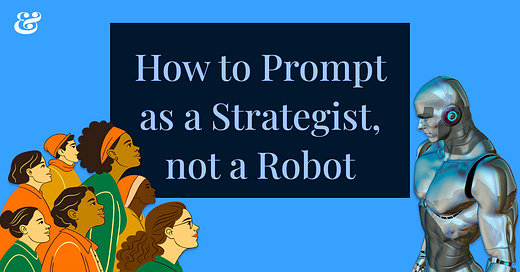#11 Stop prompting like a robot. Start briefing like a strategist
A practical guide to writing prompts that unlock insight, originality, and results—without sounding like a prompt engineer.
TL;DR
Prompting AI is like slipping a note under a locked door. The sharper, clearer, and more creative your message, the better the response.
This guide helps you:
Build better prompts with a flexible framework
Avoid vague, lifeless outputs with real-world examples
Shift from syntax obsession to human-first thinking
Use 6 proven frameworks to generate sharper, more original AI content for marketing initiatives.
This isn’t theory—it’s how I work, every day.
The Door Rule: Why Syntax Matter
Imagine this: You and a collaborator are in separate rooms. No phones. No video. No Slack. The only way to talk is to slip a note under the door.
You can’t explain yourself. That note has to carry everything—your intention, your tone, your brief.
That’s prompting AI.
That’s the Door Rule.
The output is only as good as the input—so if your prompt is vague, generic, or mechanical, you’ll get back the content equivalent of soggy toast. But when your prompt is structured, clear, and creatively charged, it unlocks serious magic.
The Anatomy of a Smart Prompt
Think of a prompt like a creative brief—it’s not just what you want, but how you want it. Here's the go-to structure:
Task – What do you want it to do? (mandatory)
Details / Requirements – What should be included, excluded, or prioritized?
Role – Who is the AI pretending to be?
Tone – How should it sound?
Format – What should the output look like?
Examples – What does "good" look like?
Context – What's the situation or backstory?
Bad Prompt vs. Better Prompt
Let’s bring the framework to life.
Bad Prompt:
“Summarize this article.” (Link to a marketing trends blog post)Why it misses:
No audience or use case
No format or tone guidance
No structure, no goal
You’ll likely get back a summary that reads like an undergrad paper—technically fine, emotionally vacant, and forgettable.
Better Prompt:
Role
You are a senior technical documentation writer at a software company.
Requirements/Goal
Your team needs a clear, actionable summary of Anthropic's agent-building article to share with the engineering department. The summary will be used to guide our AI architecture decisions and best practices.
Task
Create a comprehensive technical summary of this article about building effective AI agents.
Tone
Maintain technical accuracy while making it accessible to software engineers and product managers. Include specific examples mentioned in the text to illustrate key points.
Format the summary in markdown using:
- Main title as H1 (#)
- Major sections as H2 (##)
- Subsections as H3 (###)
- Bullet points for lists
- Bold for key terms and concepts
- Code blocks for any technical examples
- Block quotes for direct quotations
Here is an example article:
<article here>
And an example response to show you how to respond:
<example response here>Why it works:
It frames the why behind the content. It sets boundaries. It inspires. It gives AI something to aim for.
Establishes professional context through clear role definition.
Explains the purpose and intended audience.
Specifies both technical accuracy and accessibility requirements.
Requests concrete examples to ground the summary.
Provides clear formatting instructions.
🚨 Pro tip: Overloading a prompt muddies the output. Start with the essentials—task, requirements, and role—then add only what sharpens clarity or quality, only what matters. Simplicity wins.
The Mindset Shift: Think Human, Not Just Technical
When I started using AI, I obsessed over syntax. I hunted for magic prompts like they were cheat codes. But here’s the real unlock:
Prompting isn’t about mastering syntax—it’s about mastering your clarity.
You don’t need to sound like a coder. You need to think like a strategist.
AI mirrors the depth of your thinking. If you put in bland, you get back bland. If you prompt with perspective, emotion, and specificity, you get back something that thinks with you.
The real power of prompting is your ability to channel human nuance, emotional intelligence, and sharp perspective into a few lines of instruction.
If you're ready to move past the surface-level hacks and start using AI as a creative tool, keep reading. These next techniques are what I use to go from average to strategic every single day.
6 Strategic Frameworks for Better Prompting
Each of these models solves a common pain point in AI writing—generic tone, weak angles, lack of edge. Use them like tools in your kit.
1. The Loop Breaker
Problem: AI is trained on patterns and tends to return average, predictable content.
Use it when: You feel stuck in sameness or your content reads like everyone else’s.
How to use it: Add a creative constraint, unusual genre, or contradiction.
Examples:
"Describe our CRM tool like it’s a spy thriller."
"Explain attribution modeling like a break-up letter."
Why it works: It jars the model out of autopilot and encourages more inventive outputs
.
2. The Angle Amplifier
Problem: Prompts that focus only on the format (“write a blog post”) produce generic content.
Use it when: You want to uncover a unique insight or sharpen the point-of-view.
How to use it: Ask for provocative angles or challenge assumptions.
Examples:
"What’s a marketing best practice that causes harm in the long run?"
"Give me 3 surprising reasons customers churn—even when the product is good."
Why it works: Strong content comes from a strong idea. Format follows insight.
3. The Audience’s Time Machine
Problem: Vague audience definitions lead to vague outputs.
Use it when: Your messaging feels generic or lacks emotional resonance.
How to use it: Add demographic and emotional context—mindset, goals, fears.
Examples:
"Write for a CFO who thinks marketing is a cost center."
"Target a junior marketer secretly overwhelmed by AI tools."
Why it works: Humanizing the audience sharpens the relevance and tone of your content.
4. The Creative Sandwich
Problem: AI can fill in details well but often flops at compelling intros and conclusions.
Use it when: You have a clear beginning and end in mind but need help with the body.
How to use it: Provide a strong opening and closing, and ask AI to bridge the gap.
Examples:
Opening: "Everyone is talking about AI—but no one is talking about its biggest risk."
Closing: "So what’s your take? Is it hype, or the start of something deeper?"
Prompt: "Fill in the middle with 3 arguments supporting this perspective."
Why it works: You retain creative control while speeding up the middle sections.
5. The Editor’s Red Pen
Problem: First drafts are bloated, fluffy, or lacking punch.
Use it when: You’re editing or refining existing copy.
How to use it: Ask AI to critique or rewrite text for clarity, sharpness, or tone.
Examples:
"Find all the clichés in this paragraph."
"Make this copy sound like it was written by a confident strategist."
Why it works: AI becomes a fast, helpful editor—one that never tires.
6. The Third-Person Flip
Problem: Writing only for people who agree can result in bland content.
Use it when: You need to test your logic or strengthen your argument.
How to use it: Ask the AI to write from the perspective of a skeptic—or to construct and rebut an argument.
Examples:
"Make the case against using influencers in B2B—then rebut it."
"Write from the POV of a CEO who thinks AI is a fad. Change their mind."
Why it works: Arguing the other side forces clarity and sharpens your messaging.
Bringing It All Together
Let’s say you need an email about your new AI-powered analytics tool. Instead of:
“Write a product email about our analytics platform.”
Try this:
Angle Amplifier: “What’s a common myth about marketing data that we bust?”
Audience Time Machine: “Speak to a CMO who’s burnt out by dashboards and just wants clarity.”
Creative Sandwich: Write the headline and CTA yourself. Let AI connect the dots.
Boom. Now you’re not just prompting. You’re briefing.
Final Thought: AI Didn’t Kill Creativity—It Killed Lazy Thinking
Here’s the truth: You do not need to be an engineer to master prompt engineer
The best prompt engineers will be strategists, copywriters, creatives, and marketers—people who know how to frame a problem, spark an idea, and move people.
Prompting isn’t typing magic words. It’s asking smarter questions. It’s clarity, curiosity, and a little chaos—structured into a few lines of text.
So the next time you fire up ChatGPT, don’t treat it like a vending machine. Treat it like a creative partner. One that mirrors your thinking. Not replace it.
Try It Yourself
Pick one of the seven frameworks above. Use it in your next AI prompt.
See what happens. Then tweak it. Break it. Remix it.
That’s how you move from “using AI” to thinking better with it.
Let’s make AI a tool that sharpens our thinking—not one that replaces it.
Prompt Responsibly. Share Recklessly
If this helped you prompt better (or at least made you chuckle), pass it on.
Share it with:
A teammate who keeps asking AI to “write something good”
A friend who still thinks prompts need “magic words”
Or just repost it to help marketers who still think
Let’s make AI less vending machine, more creative tag-team.
And hey—if your next AI draft slaps, I expect royalties. Or memes. Either’s fine.
Subscribe Now. Regret Later. Just Kidding—You’ll Love It.
Next article’s coming in hot.
Sharper prompts. Bolder insights. Fewer clichés.










